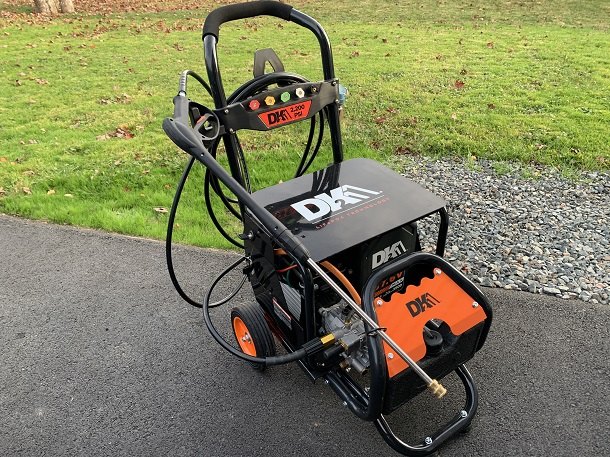Stuff We Use: Under Pressure (Washers)

On our never-ending quest to improve this place by listening to feedback from the B&B, we are taking a new tack with these product posts, choosing instead to focus on items we use and have purchased with our own meager income. After all, if we’re giving you the truth about cars, we ought to give you the truth about car accessories.
We’ve mused before on these digital pages that a clean car seems to run better – a missive that apparently holds true for sports cars and hot hatchbacks, though burly off-road pickup trucks and SUVs may take umbrage with that assessment. Nevertheless, most gearheads tend to like keeping their ride relatively clean, explaining the sheer number (and type) of pressure washers marketed toward consumers.
For ages, this writer used a gasoline-powered pressure washer, firm in the belief it ran better and more reliably than any cheap electric plug-in unit ever would. Besides, having an extension cord flailing about whilst water is sprayed wildly does not inspire confidence in the back of my brain. Perhaps I’ve watched too many episodes of CSI, studying Gil Grissom’s investigations into strange and grisly deaths.
All but identical to this example, the pressure washer was biblically loud under load but always provided great performance – even during times when the water pressure from my artesian well was less than ideal. It came with a metal lance and spray gun, a quartet of tips in different spray angles, and a decently robust metal frame. For those unfamiliar, those spray tips that attach to the end of a nozzle dictate the aggression with which the water flows forth from your pressure washer. A 25-degree tip is not as vigorous as a 10-degree, for example – though you might not wish to use the latter on yer new car. Read the manual and know what’s best for your particular task. And, yes, I speak from experience after accidentally blasting away paint that was precariously hanging on over rust bubbles on my old Ram pickup truck.
This author has recently discovered that (gasp!) battery-powered household tools have come a long way from the Bad Old Days – and are even light years ahead in terms of performance than those on sale just a few years ago. In my garage now resides, of all things, a pressure washer powered by a lithium-ion battery from a company called DK2, belting out 2,200 psi and blasting away dirt from my Challenger and house siding alike.
The battery is a large cube and sits where the gasoline engine resided on my old pressure washer, consuming about the same amount of space. Its total capacity is just over 1.0 kWh and is paired with a brushless electric motor which the manufacturer claims is very similar in construction to units found on road-going EVs. It sure seems stout and I have no reason to doubt that claim.
All the literature I could find failed to make much (official) mention of run time on a full charge but my experience so far has been very positive. It’s no trouble to wash two or three cars at a time and not run out of juice, even at my notoriously leisurely pace. The same goes for washing the siding of my home, a surface that gets reliably gnarly thanks to a droke of trees surrounding our place. It is estimated recharging takes about twice as long as discharging, though I tend to just simply plug the thing in overnight; it’s always full the next time it is needed.
In fact, the battery can apparently be used as part of a DK2 ecosystem of products which include the likes of woodchippers and log splitters. Extra batteries can be stacked for more endurance at work or turned into a power bank for home use when the grid goes dark. By itself, the battery in my pressure washer can juice items through a couple of USB ports located on its anterior side. A separate device can be purchased to provide household-style outlets if you plan to double the thing as a 2000-watt source of backup power. My sole complaint is that this is a heavy bugger, weighing more than a hundred pounds which is way more than my old gas unit. Good job it rolls easily on its tires.
As planned, this series of posts will continue to focus on items we actually use and have bought with our own money. We hope you found this one helpful.
[Image: Author]
Become a TTAC insider. Get the latest news, features, TTAC takes, and everything else that gets to the truth about cars first by subscribing to our newsletter.

Matthew buys, sells, fixes, & races cars. As a human index of auto & auction knowledge, he is fond of making money and offering loud opinions.
More by Matthew Guy
Latest Car Reviews
Read moreLatest Product Reviews
Read moreRecent Comments
- 1995 SC The Ridgeline is too new so nothing yet.The FIAT needed a tire (nail in the sidewall) and a lower steering column cover and a set of wipers. Around 200 bucksThe 30 year old Thunderbird has been needy this year. Just did fuel injectors to add to belts, hoses, motor mounts, exhaust manifold gasket, shocks and a bunch of caps replaced on various modules.Rear main has developed a small leak so I will probably have the transmission gone through when I drop it. I want to do a few things to it. I have some upgraded front calipers too but they are junk yard parts I rebuilt. Like I said, it has been needy this year but old cars do that sometimes
- Tane94 Mini annual oil change at dealership, synthetic oil and new filter, $129 but sometimes $99 when a coupon is offered.
- Mike Beranek All that chrome on the dashboard must reflect the sun something fierce. There is so much, and with so many curves, that you would always have glare from somewhere. Quite a contrast to those all-black darkroom interiors from Yurp.
- Mike Beranek 2004 Buick LeSabrepurchased in 2017, 104k, $3,100currently 287knever been jumped never been on a tow truckstruts & shocks, wheel bearings, EGR valves. A couple of O2 sensors, an oil pressure sending unit, and of course the dreaded "coolant elbows". All done in my garage with parts so plentiful there are a dozen choices of everything on Rock Auto.I've taken it to the west coast twice and the east coast once. All-in I'm under 5 grand for over 180,000 reliable miles. Best used-car purchase ever.
- Jalop1991 Our MaintenanceCosts has been a smug know-it-all.




































Comments
Join the conversation
1600 bucks? Not for me.
Since we have a freeze warning tonight, on my to-do list for today is to run some 'pump saver' through both pressure washers - the 'serious' gasoline-powered one and the wimpy plug-in electric one. And bring the 56V batteries inside the house (and 40V, and probably the M12 batteries too why not).
My electric pressure washer has its own GFCI, so the chances of electrocution are less than 27.4%.
My sister's kid works on a farm sometimes. He chose to clean his truck wheels using the Very Serious hot-water pressure washer on the farm. Which is fine if you want to remove the finish along with the dirt...
Thinking of getting (a much cheaper) one to clean off my wheels.